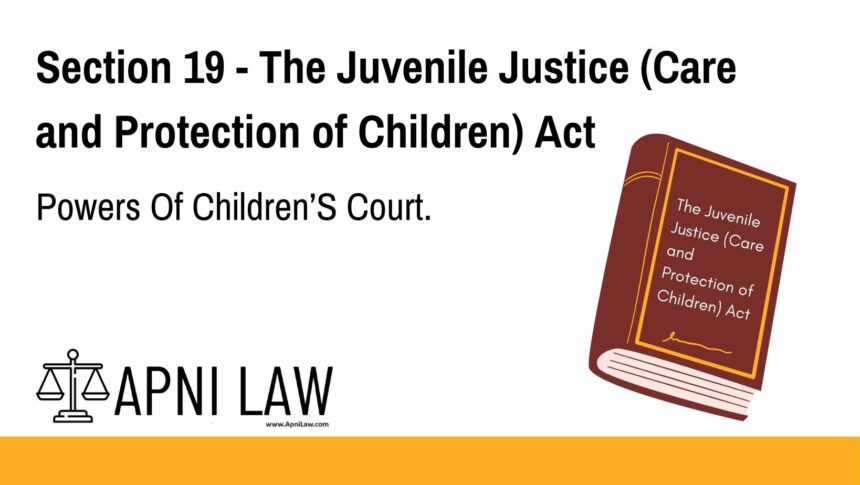Code
(1) After the receipt of preliminary assessment from the Board under section 15, the Children’s Court may decide that:
-
(i) There is a need for trial of the child as an adult, as per the provisions of the Code of Criminal Procedure, 1973 (2 of 1974), and pass appropriate orders after trial subject to the provisions of this section and section 21, considering the special needs of the child, the tenets of fair trial, and maintaining a child-friendly atmosphere.
-
(ii) There is no need for trial of the child as an adult and may conduct an inquiry as a Board and pass appropriate orders in accordance with the provisions of section 18.
(2) The Children’s Court shall ensure that the final order, with regard to a child in conflict with law, includes an individual care plan for the rehabilitation of the child, including follow-up by the probation officer or the District Child Protection Unit or a social worker.
(3) The Children’s Court shall ensure that the child who is found to be in conflict with law is sent to a place of safety till he attains the age of twenty-one years and thereafter, the person shall be transferred to a jail:
Provided that the reformative services including educational services, skill development, alternative therapy such as counselling, behaviour modification therapy, and psychiatric support shall be provided to the child during the period of his stay in the place of safety.
(4) The Children’s Court shall ensure that there is a periodic follow-up report every year by the probation officer or the District Child Protection Unit or a social worker, as required, to evaluate the progress of the child in the place of safety and to ensure that there is no ill-treatment to the child in any form.
(5) The reports under sub-section (4) shall be forwarded to the Children’s Court for record and follow-up, as may be required.
Explanation
Section 19 provides the framework for how the Children’s Court should handle cases involving children in conflict with the law. The focus is on rehabilitation, fairness, and maintaining a child-friendly approach throughout the legal process. The section lays out procedures for trial, rehabilitation plans, and follow-up mechanisms:
-
Determination of Adult Trial:
Based on the preliminary assessment by the Juvenile Justice Board, the Children’s Court will decide whether:-
The child should be tried as an adult, following the procedures of the Code of Criminal Procedure, considering the child’s age, the nature of the offence, and the child’s special needs.
-
If the child is not to be tried as an adult, the court will handle the case as per the Juvenile Justice Act, following the Board’s inquiry procedures (under Section 18).
-
-
Rehabilitation Plan:
The final order of the Children’s Court will include a comprehensive individual care plan for the rehabilitation of the child. This plan includes:-
Follow-up by probation officers, District Child Protection Units, or social workers to ensure the child’s progress and well-being.
-
-
Placement in a Place of Safety:
A child found guilty of being in conflict with the law will be sent to a place of safety until they turn 21. This place provides reformative services such as:-
Education, skill development, counselling, behaviour modification therapy, and psychiatric support.
After turning 21, the child may be transferred to a regular jail, but only after their time in the place of safety.
-
-
Periodic Follow-up:
The court ensures that the child’s progress is regularly monitored through annual follow-up reports. These reports are provided by the probation officer, District Child Protection Unit, or a social worker to evaluate:-
The child’s progress in the place of safety,
-
Ensure the child is not subjected to any form of ill-treatment.
-
-
Record Keeping:
The follow-up reports are forwarded to the Children’s Court for record-keeping and follow-up actions, ensuring the child’s rehabilitation is continuously monitored.
Illustration
Example:
-
Child in Conflict with Law: Rakesh, a 17-year-old, has been accused of a violent robbery. After a preliminary assessment under Section 15, the Children’s Court decides that Rakesh should not be tried as an adult. Instead, the court orders an individual care plan to address his rehabilitation needs.
-
Rehabilitation: Rakesh is sent to a place of safety, where he receives vocational training, counselling, and behavioural therapy. The court ensures annual follow-up reports to evaluate Rakesh’s progress and make any necessary adjustments to his rehabilitation.
Common Questions & Answers
🟩 Q1: What is the Children’s Court’s role after the preliminary assessment?
A: The court decides whether the child should be tried as an adult or proceed with the juvenile justice process. It also ensures that the child receives proper rehabilitation and follow-up care.
🟩 Q2: How does the Children’s Court ensure the child’s rehabilitation?
A: The court mandates an individual care plan that includes educational services, vocational training, therapy, and follow-up reports to track the child’s progress.
🟩 Q3: Where does a child go after being found guilty of an offence?
A: The child is placed in a place of safety, where reformative services are provided. After turning 21, they may be transferred to a regular jail, though this is only after a period of rehabilitation.
🟩 Q4: Is there any follow-up on the child’s progress in the place of safety?
A: Yes, the Children’s Court ensures that there are periodic follow-up reports every year to assess the child’s progress and ensure that they are not ill-treated.
Conclusion
Section 19 of the Juvenile Justice Act emphasizes the importance of rehabilitation and individual care in the handling of children who are in conflict with the law. By providing a care plan, periodic evaluations, and placement in a safe environment, the law aims to give children the best opportunity for reform, while ensuring that their rights and well-being are protected. This section reinforces the principle that the child’s rehabilitation should be prioritized over punitive measures.








